Gloxinia: how to properly grow a flower that looks like a violet?
Homeland gloxinia - American Tropics. It is a perennial herb or shrub with velvety or smooth leaves and delicate bell flowers. Almost all hybrid indoor gloxinia cultivated now are created from beautiful synningia. It is, unlike true gloxinia, a tuberous plant with velvety leaves. Their flowers are similar, which was the reason for the confusion with the name.
Content:
- Description and types of flower
- Reproduction of gloxinia
- Flowering care
- Gloxinia care during rest
- Plant diseases and pests
Description and types of flower
The modern hybrid gloxinia is a short-stemmed plant that grows from a rhizome-tuber. The leaves are wide, velvety, with a wavy edge. The main decoration of gloxinia is bell-shaped flowers with bent petals. They can be smooth or ruffled. The height of the peduncle ranges from 10 to 25 cm, and the diameter of the flower reaches 8 cm.
The color of the petals is varied: red, purple, white and their combinations. Often there is a motley color with spots of different sizes, a border around the edge. The petals can be arranged in two rows, forming a kind of double flower. But more often they are simple. Gloxinia blooms for about 2 months. The buds do not open at the same time, replacing each other.
Types of gloxinia:
- Brocada is a dwarf variety with small leaves and beautiful double flowers.
- Avanti with small dense leaves and large monochromatic flowers of different colors.
- Kaiser up to 30 cm high and large flowers with a white border around the edge. Kaiser Frederick blooms in red, Kaiser Wilhelm in dark purple.
- Hollywood is distinguished by large velvety flowers in various shades of purple. They decorate the bush in May and June.
Gloxinia is sometimes confused with Uzambara violet (saintpaulia). They look like leaves covered with small dense villi. The colorful flowers with delicate petals are also a bit similar. But in fact, these are different plants, although they belong to the Gesneriev family. The violet has no tuber. Its leaves are more durable and rounded, and the flower does not have the shape of a gramophone.
Gloxinia settled in the homes of Europeans in the 18th century, and the Saintpaulias a century later, in the 19th century. At the same time, violets are more common and known in our country. Everyone knows them, but many have not even seen Gloxinia. Perhaps this is due to the fact that it is more difficult to care for her. Often she does not leave the dormant period due to improper care, while the violet turns green all year round.
Reproduction of gloxinia
There are several ways gloxinia can reproduce:
- Tubers.
- By dividing the tuber.
- Leafy cuttings.
- Side stepchildren.
- Apical shoots.
- Seeds.
The tubers are planted in new soil after buds appear on them. This is about a month after moving to a warm (25 ° C) room. During this period, the tubers can be cut to increase the number of bushes. Each of the parts must have at least one kidney. Sprinkle the place of the cut with crushed charcoal. They are planted in pots, at the bottom of which a drainage layer is installed. The top of the tuber should be at ground level. They take the earth light and nutritious.In the room where the transplanted plants are located, the temperature is maintained at 18-25 degrees.
Gloxinia is often propagated by leaf or apical cuttings.
They are planted in light soil or sand. Cover with a jar to create high humidity inside. The soil is kept moist, but not flooded. Air the cuttings by opening the jar for a few minutes a day. You can germinate them in water, but they are still covered with a greenhouse. After 2 weeks, the roots germinate, and after a month the tuber appears. During this period, the cuttings are planted in pots with a drainage layer.
The most troublesome way is growing gloxinia from seeds... You can buy them at flower shops. The seeds are very small. Mix them with sand, which will allow you to get seedlings of normal density. In March, they are sown on the surface of a box with moistened soil. Cover with glass to provide the seeds with high moisture content. At a temperature of 20 degrees, shoots will appear in 10-12 days. A month later, they are dived into a new dish of small volume. Young gloxinia will bloom in six months. Having several different gloxinia bushes, you can use cross-pollination to breed a new variety, that is, get a plant with flowers of the original color.
Flowering care
Gloxinia care during the growing season is almost the same as for the Uzambara violet:
- Gloxinia is installed in a warm, bright place, protected from drafts. Lighting should be absent-minded. Do not allow direct sunlight to fall on leaves and flowers. They cause burns and even death of the plant. If the length of daylight hours is less than 14 hours, the leaves of gloxinia stretch vertically, with a sufficient amount of it, they are arranged horizontally.
- The soil in the gloxinia pot should not dry out. It is also impossible to fill it in so that the roots do not rot. Water the flower carefully, not getting on the leaves and flowers. Water droplets form stains on them. Water is taken soft, settled, its temperature should be slightly higher than room temperature. 15 minutes after watering, the excess water is drained from the pan.
- Gloxinia needs moist air to grow successfully. If it is dry, the leaves turn yellow, the buds fall off. But it is impossible to spray the flower because of the large number of small villi on the leaves and stem. Therefore, water is sprayed near the plants or trays with water are placed next to them. You can install a pot on them, but its bottom should not be in the water. In this case, the roots will rot and the gloxinia will disappear.
- For flowers to be large and bright, gloxinia need to be fed. For them, a special mineral fertilizerwhich can be purchased at a flower shop. You can use regular flowering fertilizer, but apply at half the recommended dose.
Gloxinia can be re-flowering. To do this, after flowering, it is cut off, leaving two leaves. Watered, looked after as before. Shoots will soon appear from the axils of the leaves, on which buds will subsequently form. Flowering will not be as lush as the first time.
Gloxinia care during rest
After flowering, gloxinia begins a dormant period. The leaves first stop growing, then turn yellow and disappear. This is a natural process. Stop feeding and watering the plant. The remains of leaves and stems are cut off, leaving a stump of several centimeters. The plant is taken out in a cool room until January. The temperature there should not exceed 15 ° C. You can store it directly in the pot, after watering it and laying it on its side.
Make sure that the soil does not dry out.
You can remove the tubers from the pot, rinse them and put them in a box, wrapping them sphagnum moss... They are taken out into a cool room. Periodically look around, discarding damaged tubers. In the spring, the boxes are brought into a warm room, moss, and with it the gloxinia tubers.
Young plants usually do not have time to grow a large tuber. It can dry out during storage.Such flowers are not hidden in a warm room, but continue to be watered. Insufficient light leaves and shoots stretch out and lose their attractiveness. But the mass of the tuber is growing. In the spring, the grown, elongated stem is cut off and the tuber is transplanted into a new pot. Subsequently, the plant needs to provide rest periods.
Plant diseases and pests
If gloxinia is watered with cold chlorinated water, it can develop chlorosis. Lack of light leads to stretching of the leaves and a decrease in the number of buds. But direct sunlight also does not benefit gloxinia. Burns appear on the leaves.
With proper care, gloxinia is practically not affected by pests.
Overdried hot air contributes to the defeat of plants by thrips - small flying insects. They settle on the underside of the leaf, multiply there. White larvae damage the buds. To combat them, use insecticides or spray the plant with ground sulfur. You can use an infusion of onion peel or garlic, sprinkling it on the bush once a week.
More information can be found in the video:



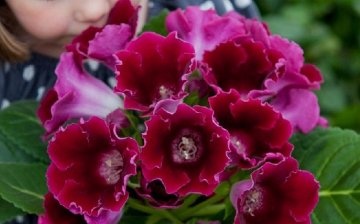
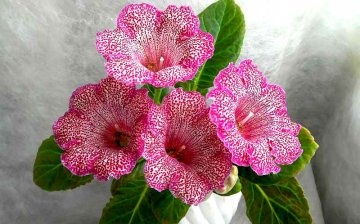
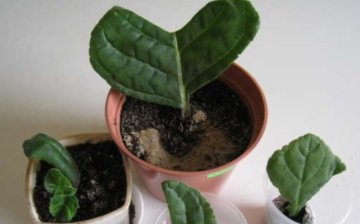
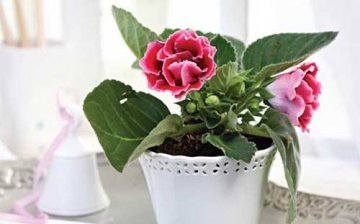
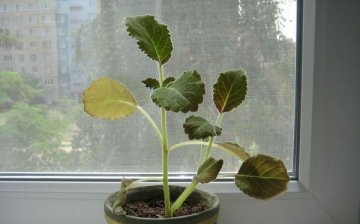
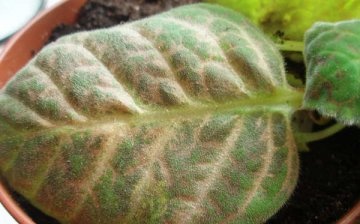






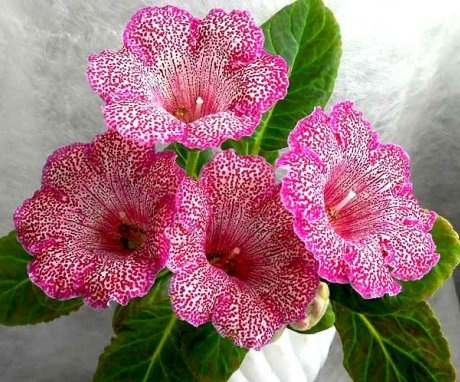
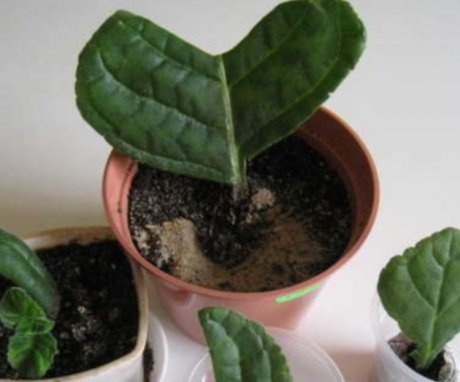
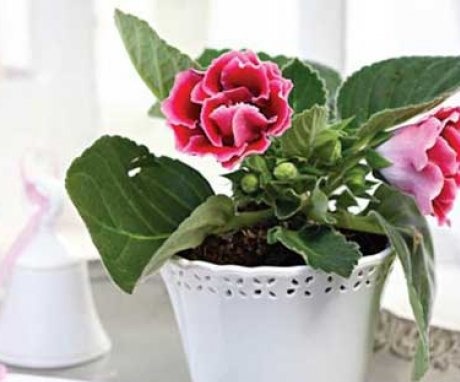


I always bred gloxinia with a whole leaf, but I saw here how they plant parts of a leaf and pack a glass into a bag. Now I will try in parts, as shown in the video.
We, too, plant mainly with a leaf similar plants like violets and gloxinia. Judging by the description, it will be difficult with this plant, since it tends to get sick and take on pests.